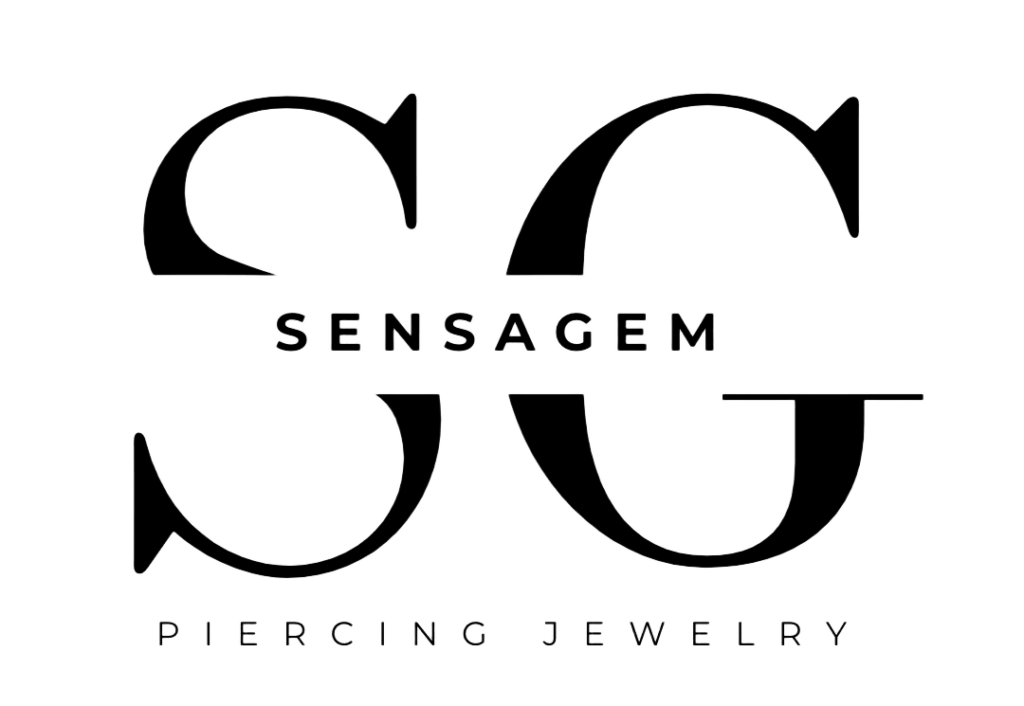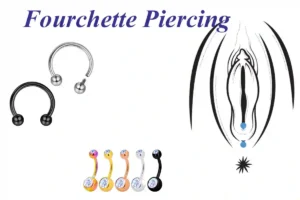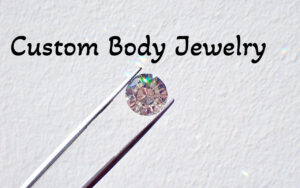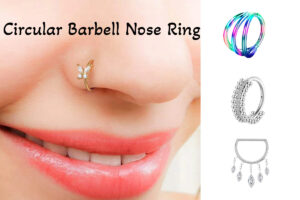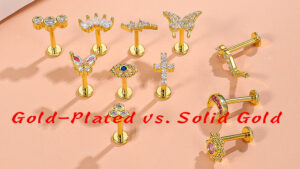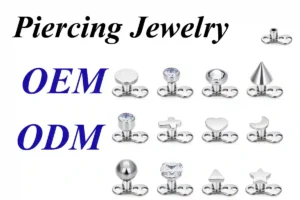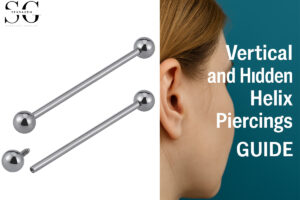Introduktion: Varför att känna till smyckenyper frågor
Oavsett om du är en erfaren piercer, en studioköpare, eller köra din egen onlinebutik, Att förstå piercing smycken är mer än bara att känna igen vackra bitar. Det handlar om struktur, säkerhet, läkande kompatibilitet - och naturligtvis - vad dina kunder ber om.
Som känner, Vi pratar med importörer, grossister, och professionella piercers över hela världen. En sak vi hör konsekvent: Ju bättre du förstår produkten, Ju lättare det är att välja (och sälja) den högra.
Den här guiden är här för att hjälpa dig att fatta dessa beslut med förtroende. Vi kommer att gå igenom alla de viktigaste typerna av piercingsmycken - hur de är byggda, Där de är slitna, Vilka material fungerar bäst - så att du kan lagra dina hyllor (och dina brickor) med smycken som faktiskt passar dina kunders behov.
1. Smycken efter struktur: Hur det är byggt påverkar hur det är slitet
Den inre konstruktionen av ett smycken kanske inte är synlig för det otränade ögat, men det påverkar direkt hur lätt det är att infoga, Hur bekvämt det känns, Och hur bra det läker.
Här är de fem vanligaste piercing smyckestrukturerna du kommer att stöta på - och när du ska använda var och en:
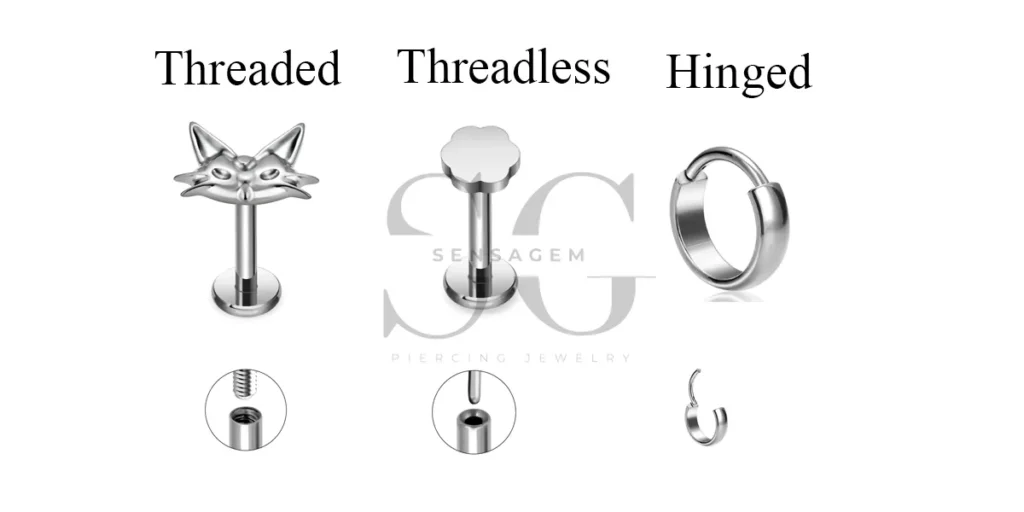
🔩 Externa gängade smycken
Detta är den äldsta och mest traditionella typen. Du kommer att känna igen det när trådar (skruvdelen) är synliga på posten. Den dekorativa änden eller kulskruvarna till det externt gängade stolpen.
Proffs:
Mer prisvärd
Allmänt tillgängligt
Nackdelar:
Trådar kan irritera den genomträngande tunneln under insättning
Inte idealisk för färska piercingar
Bäst för:
Läkt piercingar där kostnaden är en prioritering. Tänk budgetvänliga näsborrar, skivstång, etc.
🧲 Interna gängade smycken
En säkrare uppgradering från extern gängning. Här, de Trådar är dolda inuti stolpen, Och den dekorativa toppen har en liten skruv som passar inuti.
Proffs:
Smidig post: lättare att infoga utan trauma
Starkare grepp för gängade ändar
Rekommenderas av appen (Association of Professional Piercers)
Nackdelar:
Något högre kostnad på grund av mer precision i produktionen
Bäst för:
Färskt piercing, avancerade studior, Kunder med känslig hud. De flesta labRets och skivstång i professionell klass är inre gängade.
👉 Relaterad läsning: Förstå olika typer av piercing smyckestrukturer
🧷 Trådlösa smycken (Push-fit design)
Trådfria smycken är en av de mest älskade innovationerna inom modern piercing. Det använder spänningspassmekanik—Posten har ingen skruv, och den övre stiftet är något böjd för att hålla sig på plats.
Proffs:
Snabb och verktygsfri insättning
Ultra slät yta = noll irritation
Lätt att byta toppar medan du håller stolpen in
Nackdelar:
Lätt inlärningskurva för att böja stiftet korrekt
Inte alltid kompatibelt över varumärken
Bäst för:
Studior som vill ha lätthet och elegans. Perfekt för läkt läpp, näsborre, tragus, eller helixpiercing.
👉 Relaterad läsning: Hur man väljer rätt storlek för din labret piercing smycken
👉 Relaterad läsning: Vad är trådlösa piercing smycken? Varför det är populärt i moderna piercing smycken
🔒 gångjärnssegmentringar & Klickare
Klickare och gångjärnsringar är strukturerade som bågar med inbyggda låsningar. Du öppnar dem som ett dörrgångjärn och knäpper dem stängda.
Proffs:
Sömlös, rent utseende
Inga förlorade delar - allt är fäst
Bekväm och säker
Nackdelar:
Gångjärn kan slitna över tiden med upprepad öppning
Kanske inte fungerar för tjockare mätare eller komplexa placeringar
Bäst för:
Septum, resa, helix, och navelsmycken. Ett måste för mode-framåt kunder.
👉 Relaterad läsning: Cirkulär skivstång näsring: Vald, Nötning, och underhåll
🔘 Captive pärlringar (Cbrs) & Sömlösa bågar
Det här är de klassiska bågstilarna, där en liten pärla "snaps" på plats med spänning eller tryck.
Proffs:
Tidlös look
Pärlor kan vara dekorativa (ädelsten, opal, etc.)
Nackdelar:
Kan vara svårt att öppna/stänga utan verktyg
Spänningen kan lossa över tiden
Bäst för:
Lob, ögonbryn, brosk, och intima piercingar. Bra val för DIY-vänliga kunder.
2. Smycken efter form & Fungera: Matchar rätt bit till rätt piercing
Efter att ha förstått strukturen, Det näst viktigaste elementet är form- hur smycken passar på eller inuti kroppen, Hur det rör sig, Och hur det ser ut. Vissa former är designade för specifika piercingar, och att välja fel kan orsaka irritation, migrering, eller långvarig läkning.
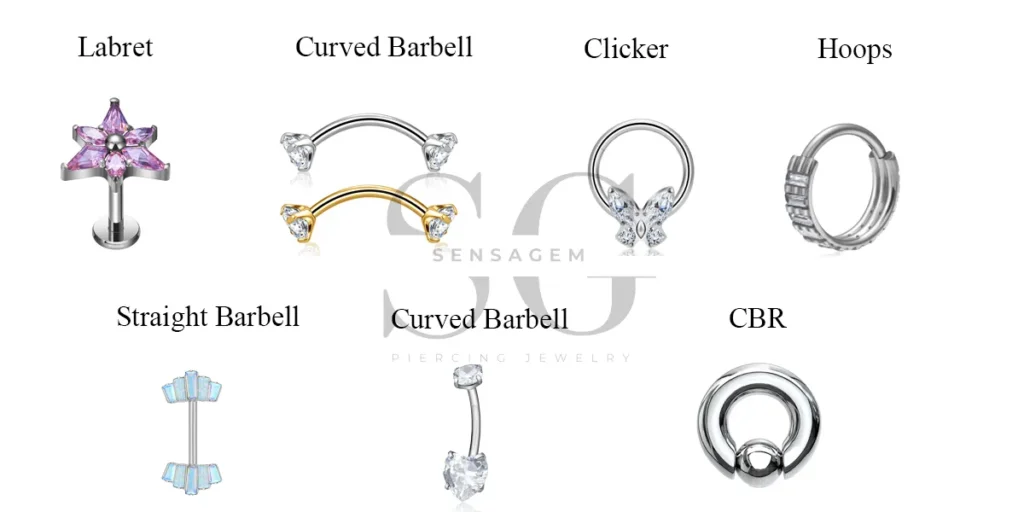
📎 Labrets
Strukturera: Platt skiva i ena änden, dekorativ topp (gängad eller trådlös) å andra sidan.
Vanliga mätare: 16G, 18G
Gemensamma längder: 6mm - 10mm
Bäst för:
Läpppiercing (labret, Monroe, medusa)
Broskpiercing (tragus, helix)
Näsborre (När en platt rygg föredras)
Proffs:
Platt skiva är bekväm inuti munnen eller bakom örat
Minimal rörelse = bättre läkning
Ofta trådlös för snabb byte
Nackdelar:
Kan sjunka i svullna piercingar om det är för kort
Platt skiva kan fånga hudskräp om det inte rengörs
👉 Tips: Titantrådfria labRets är toppval för professionella studior för initiala läpppiercingar.
🔄 Cirkulära skivstång
Strukturera: Hästskoform med gängade bollar eller spikar i båda ändarna.
Vanliga mätare: 14G, 16G
Vanlig diametrar: 8mm - 14mm
Bäst för:
Septumpiercing
Daith och Rook
Ögonbryn och bröstvårtor
Genital piercing (Prins Albert, etc.)
Proffs:
Lätt att infoga och ta bort
Dekorativa ändar tillåter anpassning
Lämplig för tjockare piercingar och sträckning
Nackdelar:
Kan rotera inuti piercing
Gängade ändar kan lossa om inte ordentligt åtdragna
👉 Se också: Cirkulär skivstång näsring: Vald & Med tips
🪝 Böjda skivstång
Strukturera: Försiktigt krökt stång med gängade ändar, vanligtvis bollformad.
Vanliga mätare: 16G, 14G
Gemensamma längder: 6mm - 12mm
Bäst för:
Ögonbrynspiercing
Navel (magknapp) piercingar
Vertikal labret
Bropiercing
Proffs:
Matchar naturliga kurvor för vissa kroppsområden
Minskar trycket på vävnad under rörelse
Snyggt och mångsidigt för flera placeringar
Nackdelar:
Inte alltid lämplig för högrörelseområden
Felaktig storlek kan orsaka migration
📌 Produktfunktion: SG6017 G23 Titanium gängad magknappring - En klassisk krökt skivstång med anodiserad regnbågsfinish.
🧿 Captive pärlringar (Cbrs)
Strukturera: Sömlös cirkulär båge med spänningshelad pärla i mitten.
Vanliga mätare: 16G, 18G
Vanlig diametrar: 8mm - 12mm
Bäst för:
Nässpiercing
Öronbrosk (helix, råka)
Läpp och ögonbryn
Proffs:
Klassiskt utseende med pärl accent
Säker när du har insatt
Finns i många färger/material
Nackdelar:
Svårt att infoga utan ringöppnare tång
Spänningen kan lossa över tiden
🔗 Segmentringar & Klickare
Strukturera: Ring med gångjärn eller avtagbart segment som klickar på plats
Vanliga mätare: 16G, 14G
Vanlig diametrar: 6mm - 12mm
Bäst för:
Septum, resa
Lob och spiral
Broskpiercing
Nippel (klickar med charm)
Proffs:
Sömlös design
Lätt att öppna/stänga utan verktyg
Säkra håll, Perfekt för känsliga områden
Nackdelar:
Gångjärn kan slitna över tiden
Dyrare på grund av komplicerad mekanism
👉 Relaterad: Trådlös design: Varför det är populärt
3. Smycken efter piercing plats: Vad man ska använda & Undvik för varje kroppsområde
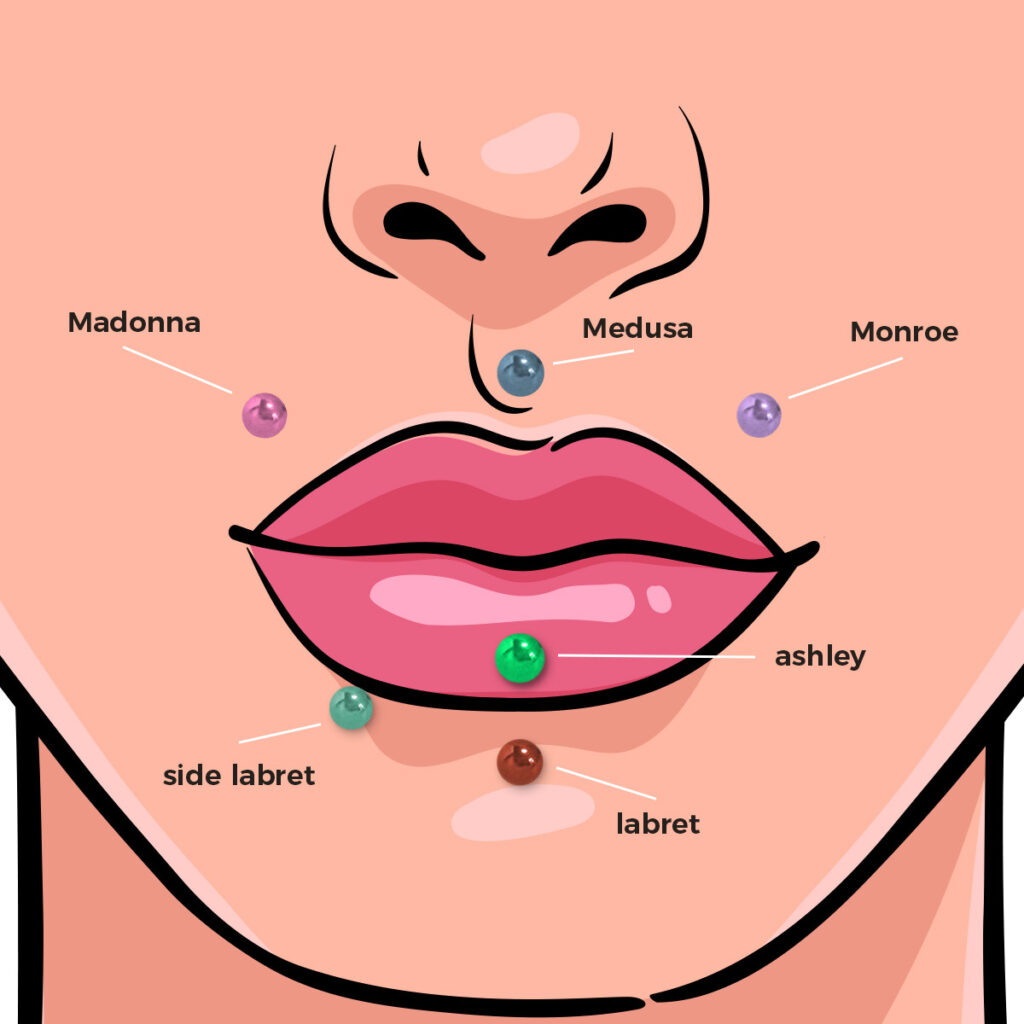
Att välja rätt smycken handlar inte bara om designen - det beror också på där det kommer att bäras. Olika piercingplatser har olika anatomiska krav. Att bära fel smycken kan orsaka irritation, Dålig läkning, eller till och med genomträngande avslag. Låt oss bryta ner de bästa smyckestilarna för varje kroppsdel och varför de spelar roll.
🔗 Relaterad läsning: Förstå olika typer av piercing smyckestrukturer
👂 öronpiercing
Folktyper: Öron, Helix, Tragus, Trasch, Industriell, Resa
Bästa smycken:
Öron: LabRets, tappar, klickare, eller små bågar
Spiral/tragus: Platt-labRets eller mikroskivstång
Industriell: Rak skivstång (vanligtvis 14g, med exakt längd baserad på anatomi)
Tips:
För färska piercingar, titan för implantatkvalitet eller 316L kirurgiskt stål är säkrast.
Industriella piercingar kräver exakta mätningar - barbeller för korta eller för länge kan orsaka migration.
👃 näspiercing
Folktyper: Näsborre, Högnäst, Septum
Bästa smycken:
Näsborre: L-formade tappar, skruv, små cbrs, och trådlösa push-fit-mönster
Septum: Cirkulär skivstång, sömlösa ringar, eller gångjärnsklickare
Tips:
Septumsmycken bör anpassas ordentligt för att sitta bekvämt inuti näsan.
Titan är idealisk för näspiercingar på grund av lägre risk för irritation.
👄 läpp & Muntlig piercing
Folktyper: Labret, Monroe, Medusa, Ormbett
Bästa smycken:
Trådlös titanlabor med platta skivryggar
Biokompatibla akryl slutar för extra komfort i munnen
Tips:
Smycken bör sitta i munnen för att undvika emaljskador
Välj kortare staplar efter att minimera rörelse och svullnad
🧠 Bonus: Nyfiken på hur trådlösa smycken fungerar? Läsa Trådlös design: Varför det är populärt
💪 Kroppspiercing
Folktyper: Navel, Nippel, Yta
Bästa smycken:
Navel: Böjd skivstång (Vanligtvis 14G, 10mm) med externt eller internt gängade bollar
Nippel: Rak skivstång eller cirkulär skivstång
Ytpiercing: Ytskivstång eller titanförankringar
Tips:
Undvik CBR i läkningsmage eller bröstvårtor; De tenderar att rotera och störa läkning
För ytpiercing, Använd flexibla eller internt gängade smycken för att förhindra avslag
🌐 Vill du lära dig mer om skivstång och böjda mönster? Checka ut Böjd skivstång: Storlek, Användning & Materiel
🔒 Intima piercingar
🔒 Intima piercingar
Folktyper: Vertikal huva (Vch), Prins Albert, Christina, Bit
Bästa smycken:
Jämna, Internt gängade titanstång eller cirkulära skivstång
Smycken måste vara anpassad och polerad för att undvika irritation
Tips:
Använd alltid certifierad, Hypoallergeniska material som ASTM F136 Titanium
Undvik hårda vinklar, grova trådar, eller billiga metalllegeringar - comfort och hygien är kritiska
4. Välja rätt material: Titan, Stål & Utöver
När det gäller piercing smycken, Material är lika mycket som stil. En fantastisk design betyder ingenting om det orsakar irritation eller försenar läkning. Oavsett om du är en studioägare, grossist, eller bara brinner för säker kroppsmodifiering, Att förstå för- och nackdelarna med vanliga material hjälper dig att välja klokt.

🧪 Titan (ASTM F136 / G23)
Varför det är populärt: Titan anses vara guldstandarden för initiala piercingar. Det är lätt, stark, icke-frätande, och helt nickelfri.
Viktiga fördelar:
✅ Hypoallergenisk (Perfekt för känslig hud)
✅ Certifierat säkert för implantation (ASTM F136 Standard)
✅ Anodiserbar i lysande färger (Lär dig mer i Anodisering för piercing smycken - Titanium vs. Rostfritt stål)
✅ Korrosionsbeständig och lätt
Bäst för: Initiala piercingar, känsliga kunder, premiumsmyckesamlingar
🔩 Kirurgiskt rostfritt stål (316L / 316Lvm)
Varför det är en favorit: Hållbar och prisvärd, Kirurgiskt stål används allmänt för både färska och läkt piercingar. Dock, den innehåller spårnickel.
Viktiga fördelar:
✅ Stark, prisvärd, och långvarig
✅ Utmärkt korrosionsmotstånd
✅ Spegelpolerad yta idealisk för kroppskontakt
Försiktighet: 316 Stål kan orsaka irritation för klienter med nickelkänslighet. I dessa fall, 316L (lågkol) eller 316LVM (vakuumbländ) Alternativ föredras.
Bäst för: Läkt piercingar, bulkorder, och vardagskläder
📖 Lär dig skillnaden: 316L vs 316 Kirurgiskt stål - Vad är bäst för piercingsmycken?
🧼 Bioplastik, Akryl & Ptfe
Varför det är trender: Icke-metalliska material som Bioplast och PTFE är idealiska för piercingar som kräver flexibilitet-som graviditetsnavellsmycken eller under MRI.
Viktiga fördelar:
✅ Flexibel och bekväm
✅ Finns i livliga färger
✅ Lämplig för tillfälliga slitage eller läkningsperioder
Försiktighet: Inte så hållbara som metaller; kan försämras över tiden. Använd endast från ansedda källor.
Bäst för: Graviditetssäker piercing, medicinska förfaranden, lätta ansiktsmycken
Material | Hypoallergen | Lämplig för färska piercingar | Kosta | Korrosionsmotstånd | Färgalternativ |
|---|---|---|---|---|---|
Titan | ✅ Utmärkt | ✅ Ja | 💲💲💲 | ✅ Utmärkt | 🌈 Ja (anodiserad) |
316L -stål | ⚠ måttlig | ⚠ med försiktighet | 💲💲 | ✅ Mycket bra | ❌ Nej |
Guld (14K+) | ✅ Bra | ✅ Ja | 💲💲💲💲 | ✅ Utmärkt | 🌟 Ja |
Bioplast/ptfe | ✅ Ja | ✅ Ja (tempanvändning) | 💲 | ⚠ måttlig | 🌈 Ja |
Niob | ✅ Utmärkt | ✅ Ja | 💲💲💲 | ✅ Utmärkt | 🌈 Ja |
5. Gängningstyper och smyckemekanik
När du väljer kroppsmycken, De flesta fokuserar på den synliga stilen eller materialet - men hur en bit öppet, slutna, eller fäste är lika viktigt. För både proffs och bärare, Att förstå trådningssystem hjälper till att säkerställa säkerhet, användarvänlighet, och tröst.
🔩 Trådade smycken
Gängade smycken består av två delar: en axel (bar) och en gängad ände som skruvar in.
Internt gängad
Trådar är dolda inuti axeln, Skapa ett smidigt inlägg som glider försiktigt genom piercingar.
✅ Bäst för färskt piercing
✅ Minimerar hudtrauma
🔗 Relaterad: Förstå olika piercing smyckestrukturer
Externt gängad
Trådar är på utsidan av baren. Detta kan orsaka obehag när det sätts in i en ny piercing.
❌ Rekommenderas inte för nya piercingar
✅ Kostnadseffektivt för läkt piercingar
Gemensamma typer: Skivstång, labRets, böjd skivstång, industribar
💡 För ett tips: Välj internt gängade stilar för professionella studior för att minska läkningskomplikationer.
🧲 Trådlösa smycken (Push-fitt)
Trådlösa system använder tryck och spänning för att hålla ändar på plats - ingen skruv krävs. En stift på den dekorativa änden är något böjd och skjuts in i en ihålig axel.
Gynn:
✅ Lätt att infoga och ta bort
✅ Slät yta, Perfekt för att läka piercingar
✅ Säker håll (När den är korrekt monterad)
✅ används allmänt i labRets, nospinnar, och brosksmycken
Bäst för: Klienter som byter topp ofta, känslig hud, läkt eller helande piercingar
🔗 Lär dig mer: Trådlös design - Varför det är populärt i moderna piercingsmycken
🔒 gångjärn och klicksmycken
Dessa stilar använder ett inbyggt gångjärn eller lås för säker stängning-perfekt för ringar och segmentsmycken.
Clicker Rings: Har ett gångjärnssegment som klickar på plats.
✅ populär i septum, resa, helix, och näspiercing
✅ Lätt enhandsoperation
✅ Stilig och säker
🔗 Se också: Cirkulär skivstång näsring: Vald & Med tips
Gångjärnssegmentring: Ringen öppnas på ett gångjärn och klickar sömlöst.
✅ Slät och snagfri
✅ Perfekt för högrörelsepiercing
Mekanism | Perfekt för | Helande vänlig | Säkra håll | Lätt att ändra | Kosta |
|---|---|---|---|---|---|
Internt gängad | Färskt piercing | ✅ Ja | ✅ Stark | ⚠ måttlig | 💲💲 |
Externt gängad | Läkt piercingar | ❌ Nej | ✅ Stark | ⚠ måttlig | 💲 |
Trådlös | Botad & helande | ✅ Ja | ✅ Stark | ✅ Mycket enkelt | 💲💲💲 |
Gångjärn/klickare | Septum, helix, resa | ✅ Ja | ✅ Säker | ✅ Lätt | 💲💲💲 |
6. Smyckestorlek: Spårvidd, Längd, och diameter
Välja rätten storlek är lika viktigt som att välja rätt material eller design. Fel mätare eller längd kan leda till obehag, migrering, eller till och med avslag på piercing. Oavsett om du är en grossist, studioägare, eller ny entusiast, Att förstå storleksstandarder är viktigt.
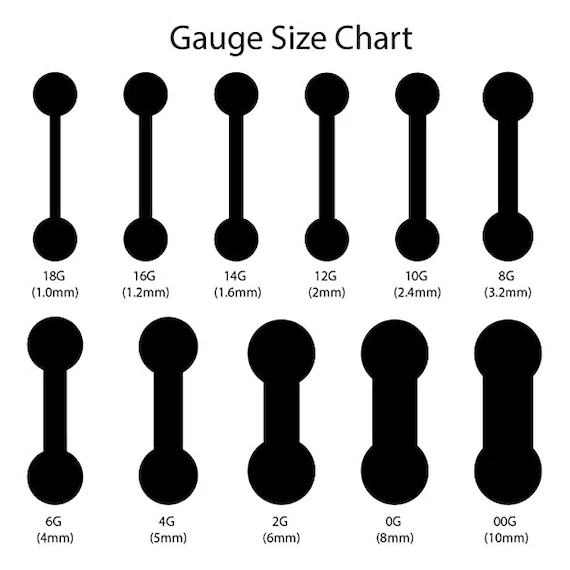
📏 mätare (Tjocklek)
Spårvidd hänvisar till tjockleken på smycken eller stolpen. Det mäts vanligtvis i Amerikansk trådmätare (Awg)—Det lägre numret, de tjockare smycken.
Spårvidd | Millimeter (mm) | Vanlig användning |
|---|---|---|
20G | ~ 0,8 mm | Näsborre, öronlober |
18G | ~ 1,0 mm | Näsa, helix |
16G | ~ 1,2 mm | Brosk, läpp, tragus |
14G | ~ 1,6 mm | Navel, industriell, nippel |
12G | ~ 2,0 mm | Sträckande piercing |
💡 För tipset: Följ alltid Piercers rekommendation eller standardstudiostorlek, speciellt för att läka piercingar.
📐 Längd
Längd är det bärbara området för en skivstång eller labret post - mätad Mellan de två ändarna.
Piercingområde | Gemensam längd |
|---|---|
Öron | 6mm - 8mm |
Tragus | 6mm |
Läpp / Labret | 8mm - 10mm |
Navel | 10mm - 12mm |
Ögonbryn | 8mm |
Industriell | 35mm - 38mm |
🔗 Relaterad: Välja den perfekta labretsmyckens storlek
🌀 diameter (För ringar)
Diameter är avståndet över insidan av en ring, uppmätt millimeter.
Piercingtyp | Typisk diameter |
|---|---|
Septum | 8mm - 10mm |
Näs | 6mm - 10mm |
Resa | 8mm |
Bröstvårtor | 12mm - 16mm |
Brosk | 6mm - 8mm |
Varför storlek är viktig
✅ För kort: Orsakar tryck, svullnad, eller inbäddning
✅ För lång: Leder till rörelse, irritation, eller snagga
✅ Högstorlek: Främjar läkning, bekvämlighet, och långvarigt slitage
Många studior rekommenderar initiala piercingar görs med något längre inlägg för att rymma svullnad - och var storleken efter läkning.
7. Material som används i piercingsmycken: Proffs, Nackdelar & Använda fall
När det gäller säkerhet, varaktighet, och estetik, material är en nyckelfaktor i piercing smycken. Fel material kan leda till allergiska reaktioner, försenad läkning, eller korrosion - medan den rätta kan säkerställa både stil och komfort i flera år.
🔩 Titan (TILL EXEMPEL., ASTM F136 / G23)
Proffs:
Hypoallergen och nickelfri
Lätt men stark
Korrosionsbeständig
Perfekt för anodisering (regnbågens färger)
Bäst för:
Färskt piercing, känslig hud, professionella studior
👉 Relaterad: Ultimate Guide to Wholesale Titanium & Smycken i rostfritt stål
👉 Se också: ASTM F136 Titanium vs. 316L rostfritt stål: Bästa materialen för piercing smycken
🔧 rostfritt stål (316L / ASTM F138)
Proffs:
Prisvärd och hållbar
Mycket korrosionsbeständig
Polerad finish, modern estetik
Nackdelar:
Innehåller spårnickel (Inte perfekt för alla)
Något tyngre än titan
Bäst för:
Läkt piercingar, industriell smycken, Stora volym B2B -köp
👉 Relaterad: 316 & 316L Piercing smycken - Varför kirurgiskt stål är det bästa valet
🧪 Bioplastik / Ptfe
Proffs:
Flexibel och bekväm
Hypoallergen
Autoklaverbar (Lämplig för sterilisering)
Nackdelar:
Mindre hållbar
Inte lämplig för varje estetik
Bäst för:
Graviditetsmagringar, Inledande läpp/labret piercingar, medicinsk användning
Materiell säkerhetstips
Se alltid till att material är auktoriserad (TILL EXEMPEL., ASTM F136 för titan eller ASTM F138 för stål) och hämtas från ansedda tillverkare. Undvik generiskt "kirurgiskt stål" eller mysteriummetaller utan spårbarhet.
🔗 Relaterad: Piercing smyckescertifiering - Förståelse av rostfritt stål & Titanmaterial
8. Smycken stöd och stängningar: Funktionella och stilöverväganden
Typen av stängningsmekanism Används i piercing smycken är inte bara en fråga om bekvämlighet - det påverkar komfort, hygien, säkerhet, och estetik. Olika stängningar tjänar olika syften baserat på piercingplatsen, personlig preferens, och livsstilsbehov.
🔒 Vanliga stängningstyper:
1. Gängad (Inre & Extern)
Inre tråd: Inlägget är smidigt, Och gängningen är inne; Perfekt för initiala piercingar (Mindre vävnadstrauma)
Extern tråd: Tråden är på utsidan av inlägget; Mer prisvärd men mindre idealisk för färska piercingar
✅ Rekommenderad för: Labret, skivstång, tunga ringar, industribaggar
🔗 Relaterad: Trådlös design: Varför det är populärt
2. Trådlös (Push-fitt / Presspassning)
Använder spänningar istället för skruvtrådar
Renare utseende, enklare insättning/borttagning
Särskilt populärt i moderna studior och högre smycken
✅ Rekommenderad för: Helix, näsborre, tragus, labretsmycken
👉 Se också: Välja den perfekta labretsmyckens storlek
3. Klickare
Gångjärnssegmentring som klickar på plats
Lätt att öppna och stänga, säkra passform
Perfekt för sömlös look i näsan, septum, från piercing -resan
✅ Rekommenderad för: Septum, resa, helix, broskpiercing
🔗 Relaterad: Cirkulär skivstång näsring: Vald & Med tips
4. Fångsting (Cbr)
Klassisk stil där en enda pärla hålls av spänning
Erbjuder 360 ° rotation, minimal design
Något svårare att infoga/ta bort
✅ Rekommenderad för: Öron, näsborre, nippel, ögonbryn
5. Fast boll eller ingen stängning (Sömlös)
Erbjuder en minimal look
Vissa sömlösa ringar kräver böjning för att öppna/stänga
Inte idealisk för konstant förändring
✅ Rekommenderad för: Näsborre, helix, trasch
Hur man väljer rätt stängning:
Hänsyn | Bästa alternativ |
|---|---|
Första gången piercing | Trådlös eller intern tråd |
Vardagskläder | Klickare eller trådlös |
Minimalistisk look | Sömlös eller fast pärla |
Säkra håll för aktiva användare | Gängad eller klickare |
Att välja rätt stängning handlar inte bara om utseende -bekvämlighet, säkerhet, och enkel rengöring är lika viktiga. Om du är osäker, Trådfria smycken eller klickarstil erbjuder det bästa av båda världarna.
9. Hur man matchar smycken typ till piercing plats
Inte alla smyckenyper är lämpliga för varje piercing. Välja rätten strukturera, form, och material för en specifik plats kan påverka läkningstiden, bekvämlighet, och långsiktig bärbarhet. Här är en plats-för-platsguide som hjälper dig eller dina kunder att fatta välgrundade beslut.
👂 öronpiercing
Lob:
Bäst för: Tappar, labRets, fångstpärlringar
Anteckningar: Läker snabbt; mångsidig för många stilar
Helix / Brosk:
Bäst för: Skivstång, klickare, tappar
Anteckningar: Tunnare, längre läkningstid - smidiga kanter är ett måste
Tragus / Resa / Råka:
Bäst för: Cirkulär skivstång, klickare, böjd skivstång
Anteckningar: Välj mindre mätare och bekväma stängningar
👃 näspiercing
Näsborre:
Bäst för: Nospinnar, bågar, L-formade stift
Anteckningar: Välj platta ryggar eller skruvstänger för att förhindra irritation
🔗 Relaterad: Välja den perfekta labretsmyckens storlek
Septum:
Bäst för: Cirkulär skivstång, klickare, sömlösa ringar
Anteckningar: Undvik skarpa kanter eller tunga bitar under läkning
👄 läpp & Muntlig piercing
Labret / Monroe / Medusa:
Bäst för: Platt-labRets, trådlösa inlägg
Anteckningar: Leta efter smycken med släta ryggar för att skydda tandkött och tänder
🔗 Relaterad: Trådlös design: Varför det är populärt
Tunga:
Bäst för: Skivstång (titan föredraget)
Anteckningar: Använd internt gängade smycken för att minska vävnadsskadorna
💉 Ögonbrynspiercing
Bäst för: Böjda skivstång eller ytstänger
Anteckningar: Undvik stora smycken; Gå efter lättare alternativ för komfort
✨ Kroppspiercing
Navel (Magknapp):
Bäst för: Böjd skivstång, dingle navel ringar
Anteckningar: Undvik alltför tunga dinglar för färska piercingar
Nippel:
Bäst för: Skivstång, klickare, sköld
Anteckningar: Välj material med utmärkt biokompatibilitet som 316L eller F136 titan
🔗 Relaterad: Säkerhetsguide för bästa piercing smyckematerial
10. Materialval för varje smycketyp
Välja rätten material är lika viktigt som att välja smyckestilen. Fel material kan orsaka irritation, försena läkning, eller till och med leda till allergiska reaktioner - särskilt i färska piercingar. Nedan följer en snabb översikt över vanliga material och deras bästa användning:
🛡 Titan (ASTM F136 / F1295)
Bäst för: Alla piercingar, särskilt färska
Varför välja det:
Hypoallergen och biokompatibel
Lätt och korrosionsbeständig
Perfekt för anodisering (livliga färgalternativ)
🔗 Relaterad: F136 Titanium vs. 316L rostfritt stål - bäst för piercing smycken
🧲 316L kirurgiskt rostfritt stål
Bäst för: Läkt piercingar, budgetmedvetna alternativ
Varför välja det:
Prisvärd och allmänt tillgänglig
Hållbar med anständigt korrosionsmotstånd
Kan innehålla spårnickel (Inte idealisk för ultrakänslig hud)
🔗 Relaterad: 316 & 316L Piercing smycken - Varför kirurgiskt stål är det bästa valet
🌿 Bioflex & Ptfe (Flexibel plast)
Bäst för: Muntlig piercing, graviditet, medicinska förfaranden
Varför välja det:
Flexibel och lätt
Metallfri (Säkert för avbildning, operationer)
Perfekt för behållare och tillfälliga ersättare
Pro tips för materialval
Nya piercingar? Håll fast vid titan eller 316L stål
Känslig hud? Bli nickelfri-titan är din bästa vän
Stilfokuserade köpare? Erbjud ett guld- eller anodiserat titanalternativ
Studior/återförsäljare? Verifiera alltid certifieringar (TILL EXEMPEL., ASTM F136, Fabrikscertifiering)
11. Gängtyper: Gängad, Trådlös & Clicker förklarade
När det gäller mekanism som håller dina smycken ihop, Trådstilen spelar en stor roll i både komfort och praktiska. Så här fungerar varje typ och när man ska använda dem:
🔩 Trådade smycken
Beskrivning: Det dekorativa slutet (bästa) är skruvad på stolpen/baren.
Extern tråd: Trådar är på utsidan av inlägget. Mindre idealisk för att läka piercingar eftersom det kan skrapa vävnad.
Inre tråd: Trådar är inne i posten - Safer och jämnare under införande.
✅ Bäst för: Erfarna användare och säkra applikationer som skivstång eller industrier.
✨ Trådlösa smycken (Push-fitt)
Beskrivning: En flexibel stift på den dekorativa änden skjuts in i en ihålig stolpe, spänning.
Enklare och snabbare att infoga
Ingen gängning = mindre trauma under förändringar
Populärt bland studior för näsa, öra, och labret piercingar
🔗 Relaterad: Trådlösa smycken: Varför det är populärt i moderna piercingar
🔁 Klicksmycken
Beskrivning: Har ett gångjärn och lås som "klickar" stängs.
Sömlös look
Inga verktyg krävs
Vanligt i septum, resa, helix, och broskpiercing
Snabbjämförelse
Typ | Säkra? | Lätt att ändra? | Bäst för |
|---|---|---|---|
Gängad | ✅ Hög | ❌ Måttlig | Skivstång, industrier |
Trådlös | ✅ Hög | ✅ Mycket enkelt | Näsa, mun, örnpinnar |
Klickare | ✅ Hög | ✅ Mycket enkelt | Septum, resa, helix, ringar |
12. Piercing smyckestorlekar: Mätare, Längd & Diametrar
Att välja rätt storlek är lika viktigt som att välja rätt material eller stil - särskilt när det gäller komfort, helande, och estetik.
📏 Vad är en mätare?
De spårvidd (G) mäter den smycken eller barens tjocklek.
Lägre nummer = tjockare smycken (TILL EXEMPEL., 14G är tjockare än 18 g)
Vanliga mätare:
20G - 18G: näsringar, örnpinnar
16G - 14G: brosk, septum, läpp, och ögonbryn
12G och högre: sträckta piercingar, industrier
👉 Relaterad: Välja den perfekta labretsmyckens storlek
📐 Längd och diameter
Längd hänvisar till hur länge den bärbara delen är (TILL EXEMPEL., post eller skivstång)
Diameter gäller cirkulära smycken som hoops, Cbrs, och klickare
Exempel på referenstabell:
Piercingtyp | Rekommenderad mätare | Rekommenderad längd/diameter |
|---|---|---|
Näsborre | 18G - 20 g | 6mm - 8 mm (posta) / 8mm - 10 mm (ringa) |
Labret/läpp | 14G - 16G | 6mm - 10 mm |
Ögonbryn | 16G | 8mm - 10 mm |
Navel | 14G | 10mm |
Spiral/brosk | 16G | 6mm - 8 mm |
Septum | 14G - 16G | 8mm - 10 mm |
⚠ Storlek är viktig för läkning
För tätt = tryck, svullnad, irritation
För lös = snagging, migreringsrisk
💡 Kontakta alltid en professionell piercer när du är osäker på korrekt storlek.
13. Material för piercing smycken: Beyond Titanium & Rostfritt stål
Medan titan och 316L rostfritt stål förbli guldstandarden i piercing smycken, Andra material används också i specifika sammanhang. Låt oss titta närmare:
🛠 Populära material på marknaden
Material | Nyckelfunktioner | Fall för bästa användningsanvändning |
|---|---|---|
Titan (ASTM F136) | Hypoallergen, lättvikt, korrosionsbeständig | Initiala piercingar, känslig hud, Anodiserande |
316L rostfritt stål | Hållbar, polerad, prisvärd | Läkt piercingar, estetisk sort |
Niob | Hypoallergen, Liknar titan, Bra för anodisering | Initiala piercingar, färganpassning |
Guld (14K+) | Biokompatibelt om nickelfri, elegant | Läkt piercingar, lyxiga kroppsmycken |
Bioplast/ptfe | Flexibel, nickelfri, autoklaverbar | Graviditetspiercing, medicinsk/sportanvändning |
Glas (Borilikat) | Jämna, inert, icke-metallisk | Öronproppar, tunnlar, septumhållare |
Trä, Horn, Sten | Organisk, andlig, handgjord | Sträckta lober (Först efter full läkning) |
❗ Material att undvika
Mystery Metals eller icke-certifierat "kirurgiskt stål"
Akryl för färska piercingar (icke-autoklaverbar, porös)
Pläterade eller belagda metaller (kan chip eller orsaka reaktioner)
👉 Relaterad: Säkerhetsguide för bästa piercing smyckematerial
14. Smycken trender & Stiltips för studior och återförsäljare
Att hålla sig på toppen av piercing smycketrender är inte bara för modälskare - det är avgörande för återförsäljare, studioägare, och distributörer som vill hålla sig konkurrenskraftig på en snabbt rörande marknad. Här är några topptrender och praktiska tips som formar kundpreferenser i 2025.
🔮 Emerging trender i piercing smycken
1. Minimalistisk & Mikrodesign
Ultra-små labRets, tappar, och hoops är trendiga.
Populära för andra och tredje öronlobspiercing, näsborre, och Helix.
Matt och borstade ytor i titan får dragkraft.
2. Färganpassning
Anodiserat titan i blå, regnbåge, purpur, och guld Finish är att se en våg.
Studior erbjuder färgalternativ per piercingområde (TILL EXEMPEL., guld för näsborrar, regnbåge för brosk).
👉 Relaterad: Förstå anodiseringsprocess - titan vs rostfritt stål
3. Trådlösa smyckesystem
Växer i popularitet på grund av användarvänlighet och säker passform.
Speciellt gynnad av professionella piercers för första smycken.
4. Etiskt tillverkad & Certifierade smycken
Gen Z och Millennial -köpare är mer medvetna om inköp.
Smycken med räckvidd, Astm, eller appcertifieringar krävs alltmer.
5. Stapling & Blandningsstilar
Kunder blandas skivstång, bågar, och klickare över samma öron eller ansiktsregion.
Studior drar nytta av att erbjuda uppsättningar eller kuraterade buntar.
Stiltips för återförsäljare & Studior
Dricks | Förmån |
|---|---|
Erbjud flera storlekar & tjocklekar per modell | Hjälper till att passa unik anatomi, minskar avkastningsgraden |
Ge anodiserande färgdiagram i butik eller online | Ger kunder möjlighet att anpassa val |
Utbilda personal om materialcertifieringar | Bygger förtroende och ökar försäljningen |
Hålla högst upp 5 Stilar i lager hela tiden | Minskar väntetiden, ökar omvandlingen |
Visa kuraterade samlingar av Piercing Area | Förbättrar kundupplevelse och beslutsfattande |
15. Slutliga tips för att välja rätt smycken för ditt företag & Klienter
Oavsett om du är en piercingstudio, onlinehandlare, eller grossist, Att erbjuda rätt typer av smycken är nyckeln till framgång. Här är en snabb checklista som hjälper dig att anpassa dina produktutbud till vad kunder letar efter:
✅ Materialfrågor
Alltid lager titan (ASTM F136) och 316L kirurgiskt stål Som dina basmetaller. Dessa är biokompatibla, auktoriserad, och litar på av professionella piercers.
👉 Lär dig mer: Ultimate Guide to Wholesale Titanium & Smycken i rostfritt stål
✅ Fokusera på fit & Fungera
Erbjuda en rad Postlängder och mätare för att passa olika anatomier.
Prioritera trådlös eller internt gängad mönster för initiala piercingar.
Tänk på ergonomi: böjda skivstång för navlar, Straight for Industrials, gångjärnsringar för septum, etc.
✅ Lyssna på studiotrender
Fråga regelbundet dina B2B -klienter:
Vilka stilar är populära just nu?
Är kunder som ber om specifika ytor (matt, anodiserad, polerad)?
Behöver de små partier med anpassade eller färgkodade smycken?
✅ Kurat för piercingområden
Istället för att bara erbjuda SKU, skapa avsnitt som:
“Smycken för nostril piercings”
”Bästa klickare för septum & Rida ”
“Topplärnor för Helix & Läpp"
✅ Bygg förtroende med dokumentation
Märk tydligt alla material och tillverkningsspecifikationer.
Erbjud certifikat för ursprung eller kvarntestrapporter för titan och kirurgiskt stål.
Ge tips med lätt rengöring och eftervård med köp.
📦 Bonustips: Startersatser för studior
Buntsmycken efter typ eller piercingområde (TILL EXEMPEL., “Starteruppsättning för öronprojekt”) För att hjälpa nya studior eller återförsäljare att testa olika stilar med minimal risk.
Om du vill fylla i högkvalitativt grossistpiercing smycken tillverkade av certifierat titan och rostfritt stål, Sensagem är här för att hjälpa till.
Kontakta oss för anpassade citat, kataloger, eller provkit som är anpassade till din marknad.
Vill du att jag ska sammanställa alla avsnitt i en formaterad exportklara artikel, eller börja arbeta med det första klusterartikel I detta andra innehållskluster?
